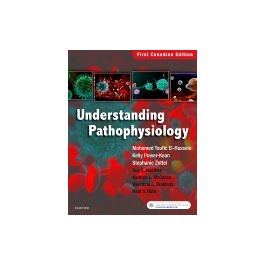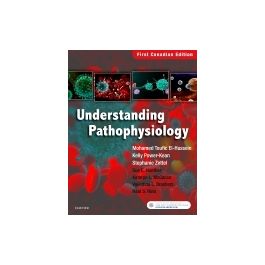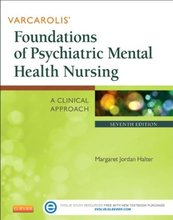This is completed downloadable of Test Bank for Understanding Pathophysiology 1st Canadian Edition By Huether

Product Details:
- ISBN-10 : 1771721170
- ISBN-13 : 978-1771721172
- Author:
Learn the what, how, and why of pathophysiology within a Canadian context! With easy-to-read, in-depthdescriptions of disease, disease etiology, and disease processes, Understanding Pathophysiology, Canadian Edition helps you understand the most important and most complex pathophysiology concepts. Including more than 1,000 full-colour illustrations and photographs, this text makes it easier to identify normal anatomy and physiology, as well as alterations of structure and function. With the most accurate information on treatments, manifestations, and mechanisms of disease across the lifespan, this first-edition text gives you the fundamental knowledge you need to succeed in your nursing education and career!
Table of Content:
- Part One Basic Concepts of Pathophysiology
- Unit 1 The Cell
- 1 Cellular Biology
- Prokaryotes and Eukaryotes
- Cellular Functions
- Structure and Function of Cellular Components
- Cell-to-Cell Adhesions
- Cellular Communication and Signal Transduction
- Cellular Metabolism
- Membrane Transport: Cellular Intake and Output
- Cellular Reproduction: The Cell Cycle
- Tissues
- Did You Understand?
- Key Terms
- References
- 2 Genes and Genetic Diseases
- DNA, RNA, and Proteins: Heredity at the Molecular Level
- Chromosomes
- Elements of Formal Genetics
- Transmission of Genetic Diseases
- Linkage Analysis and Gene Mapping
- Multifactorial Inheritance
- Did You Understand?
- Key Terms
- References
- 3 Epigenetics and Disease
- Epigenetic Mechanisms
- Epigenetics and Human Development
- Genomic Imprinting
- Inheritance of Epigenetic States
- Epigenetics and Cancer
- Future Directions
- Did You Understand?
- Key Terms
- References
- 4 Altered Cellular and Tissue Biology
- Cellular Adaptation
- Cellular Injury
- Manifestations of Cellular Injury: Accumulations
- Cellular Death
- Aging and Altered Cellular and Tissue Biology
- Somatic Death
- Did You Understand?
- Key Terms
- References
- 5 Fluids and Electrolytes, Acids and Bases
- Distribution of Body Fluids and Electrolytes
- Alterations in Water Movement
- Sodium, Chloride, and Water Balance
- Alterations in Sodium, Chloride, and Water Balance
- Alterations in Potassium and Other Electrolytes
- Acid-Base Balance
- Pediatric Considerations
- Geriatric Considerations
- Did You Understand?
- Key Terms
- References
- Unit 2 Mechanisms of Self-Defence
- 6 Innate Immunity
- Human Defence Mechanisms
- Acute and Chronic Inflammation
- Wound Healing
- Pediatric Considerations
- Geriatric Considerations
- Did You Understand?
- Key Terms
- References
- 7 Adaptive Immunity
- Third Line of Defence: Adaptive Immunity
- Antigens and Immunogens
- Antibodies
- Immune Response: Collaboration of B Cells and T Cells
- Cell-Mediated Immunity
- Pediatric Considerations
- Geriatric Considerations
- Did You Understand?
- Key Terms
- References
- 8 Infection and Defects in Mechanisms of Defence
- Infection
- Deficiencies in Immunity
- Hypersensitivity: Allergy, Autoimmunity, and Alloimmunity
- Did You Understand?
- Key Terms
- References
- 9 Stress and Disease
- Historical Background and General Concepts
- The Stress Response
- Stress, Personality, Coping, and Illness
- Geriatric Considerations
- Did You Understand?
- Key Terms
- References
- Unit 3 Cellular Proliferation: Cancer
- 10 Biology of Cancer
- Cancer Terminology and Characteristics
- The Biology of Cancer Cells
- Clinical Manifestations of Cancer
- Diagnosis, Characterization, and Treatment of Cancer
- Did You Understand?
- Key Terms
- References
- 11 Cancer Epidemiology
- Genetics, Epigenetics, and Tissue
- Incidence and Mortality Trends
- In Utero and Early Life Conditions
- Environmental and Lifestyle Factors
- Did You Understand?
- Key Terms
- References
- 12 Cancer in Children and Adolescents
- Incidence, Etiology, and Types of Childhood Cancer
- Prognosis
- Did You Understand?
- Key Terms
- References
- Part Two Body Systems and Diseases
- Unit 4 The Neurological System
- 13 Structure and Function of the Neurological System
- Overview and Organization of the Nervous System
- Cells of the Nervous System
- The Nerve Impulse
- The Central Nervous System
- The Peripheral Nervous System
- The Autonomic Nervous System
- Geriatric Considerations
- Did You Understand?
- Key Terms
- References
- 14 Pain, Temperature, Sleep, and Sensory Function
- Pain
- Temperature Regulation
- Sleep
- The Special Senses
- Somatosensory Function
- Geriatric Considerations
- Geriatric Considerations
- Geriatric Considerations
- Did You Understand?
- Key Terms
- References
- 15 Alterations in Cognitive Systems, Cerebral Hemodynamics, and Motor Function
- Alterations in Cognitive Systems
- Alterations in Cerebral Hemodynamics
- Alterations in Neuromotor Function
- Alterations in Complex Motor Performance
- Extrapyramidal Motor Syndromes
- Did You Understand?
- Key Terms
- References
- 16 Disorders of the Central and Peripheral Nervous Systems and Neuromuscular Junction
- Central Nervous System Disorders
- Peripheral Nervous System and Neuromuscular Junction Disorders
- Tumours of the Central Nervous System
- Did You Understand?
- Key Terms
- References
- 17 Alterations of Neurological Function in Children
- Development of the Nervous System in Children
- References
- Structural Malformations
- Alterations in Function: Encephalopathies
- Cerebrovascular Disease in Children
- Childhood Tumours
- Did You Understand?
- Key Terms
- References
- Unit 5 The Endocrine System
- 18 Mechanisms of Hormonal Regulation
- Mechanisms of Hormonal Regulation
- Structure and Function of the Endocrine Glands
- Geriatric Considerations
- Did You Understand?
- Key Terms
- References
- 19 Alterations of Hormonal Regulation
- Mechanisms of Hormonal Alterations
- Alterations of the Hypothalamic-Pituitary System
- Alterations of Thyroid Function
- Alterations of Parathyroid Function
- Dysfunction of the Endocrine Pancreas: Diabetes Mellitus
- Alterations of Adrenal Function
- Did You Understand?
- Key Terms
- References
- Unit 6 The Hematological System
- 20 Structure and Function of the Hematological System
- Components of the Hematological System
- Development of Blood Cells
- Mechanisms of Hemostasis
- Pediatric Considerations
- Geriatric Considerations
- Did You Understand?
- Key Terms
- References
- 21 Alterations of Hematological Function
- Alterations of Erythrocyte Function
- Myeloproliferative Red Blood Cell Disorders
- Alterations of Leukocyte Function
- Alterations of Lymphoid Function
- Alterations of Splenic Function
- Hemorrhagic Disorders and Alterations of Platelets and Coagulation
- Did You Understand?
- Key Terms
- References
- 22 Alterations of Hematological Function in Children
- Disorders of Erythrocytes
- Disorders of Coagulation and Platelets
- Neoplastic Disorders
- Did You Understand?
- Key Terms
- References
- Unit 7 The Cardiovascular and Lymphatic Systems
- 23 Structure and Function of the Cardiovascular and Lymphatic Systems
- The Circulatory System
- The Heart
- The Systemic Circulation
- The Lymphatic System
- Did You Understand?
- Key Terms
- References
- 24 Alterations of Cardiovascular Function
- Diseases of the Veins
- Diseases of the Arteries
- Disorders of the Heart Wall
- Manifestations of Heart Disease
- Shock
- Did You Understand?
- Key Terms
- References
- 25 Alterations of Cardiovascular Function in Children
- Congenital Heart Disease
- Acquired Cardiovascular Disorders
- Did You Understand?
- Key Terms
- References
- Unit 8 The Pulmonary System
- 26 Structure and Function of the Pulmonary System
- Structures of the Pulmonary System
- Function of the Pulmonary System
- Geriatric Considerations
- Did You Understand?
- Key Terms
- References
- 27 Alterations of Pulmonary Function
- Clinical Manifestations of Pulmonary Alterations
- Disorders of the Chest Wall and Pleura
- Pulmonary Disorders
- Did You Understand?
- Key Terms
- References
- 28 Alterations of Pulmonary Function in Children
- Disorders of the Upper Airways
- Disorders of the Lower Airways
- Sudden Unexpected Infant Death
- Did You Understand?
- Key Terms
- References
- Unit 9 The Renal and Urological Systems
- 29 Structure and Function of the Renal and Urological Systems
- Structures of the Renal System
- Renal Blood Flow
- Kidney Function
- Tests of Renal Function
- Pediatric Considerations
- Geriatric Considerations
- Did You Understand?
- Key Terms
- References
- 30 Alterations of Renal and Urinary Tract Function
- Urinary Tract Obstruction
- Urinary Tract Infection
- Glomerular Disorders
- Acute Kidney Injury
- Chronic Kidney Disease
- Did You Understand?
- Key Terms
- References
- 31 Alterations of Renal and Urinary Tract Function in Children
- Structural Abnormalities
- Glomerular Disorders
- Nephroblastoma
- Bladder Disorders
- Urinary Incontinence
- Did You Understand?
- Key Terms
- References
- Unit 10 The Reproductive Systems
- 32 Structure and Function of the Reproductive Systems
- Development of the Reproductive Systems
- The Female Reproductive System
- Structure and Function of the Breast
- The Male Reproductive System
- Aging and Reproductive Function
- Did You Understand?
- Key Terms
- References
- 33 Alterations of the Female Reproductive System
- Abnormalities of the Female Reproductive Tract
- Alterations of Sexual Maturation
- Disorders of the Female Reproductive System
- Disorders of the Female Breast
- Did You Understand?
- Key Terms
- References
- 34 Alterations of the Male Reproductive System
- Alterations of Sexual Maturation
- Disorders of the Male Reproductive System
- References
- Disorders of the Male Breast
- Sexually Transmitted Infections
- Did You Understand?
- Key Terms
- References
- Unit 11 The Digestive System
- 35 Structure and Function of the Digestive System
- The Gastro-Intestinal Tract
- Accessory Organs of Digestion
- Geriatric Considerations
- Did You Understand?
- Key Terms
- References
- 36 Alterations of Digestive Function
- Disorders of the Gastro-Intestinal Tract
- Disorders of the Accessory Organs of Digestion
- Cancer of the Digestive System
- Did You Understand?
- Key Terms
- References
- 37 Alterations of Digestive Function in Children
- Disorders of the Gastro-Intestinal Tract
- Disorders of the Liver
- Gastro-Intestinal Malignancies in Children
- Did You Understand?
- Key Terms
- References
- Unit 12 The Musculo-skeletal and Integumentary Systems
- 38 Structure and Function of the Musculo-skeletal System
- Structure and Function of Bones
- Structure and Function of Joints
- Structure and Function of Skeletal Muscles
- Aging and the Musculo-skeletal System
- Did You Understand?
- Key Terms
- References
- 39 Alterations of Musculo-skeletal Function
- Musculo-skeletal Injuries
- Disorders of Bones
- Disorders of Joints
- Disorders of Skeletal Muscle
- Musculo-skeletal Tumours
- Did You Understand?
- Key Terms
- References
- 40 Alterations of Musculo-skeletal Function in Children
- Congenital Defects
- Bone Infection
- Juvenile Idiopathic Arthritis
- Osteochondroses
- Scoliosis
- Muscular Dystrophy
- Musculo-skeletal Tumours
- Nonaccidental Trauma
- Did You Understand?
- Key Terms
- References
- 41 Structure, Function, and Disorders of the Integument
- Structure and Function of the Skin
- Disorders of the Skin
- Disorders of the Hair
- Disorders of the Nail
- Geriatric Considerations
- Did You Understand?
- Key Terms
- References
- 42 Alterations of the Integument in Children
- Acne Vulgaris
- Dermatitis
- Infections of the Skin
- Insect Bites and Parasites
- Cutaneous Hemangiomas and Vascular Malformations
- Other Skin Disorders
- Did You Understand?
- Key Terms
- References
- Index
- Prefixes and Suffixes Used in Medical Terminology
- Word Roots Commonly Used in Medical Terminology





